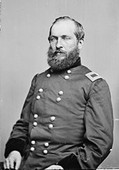Middle Creek National Battlefield
Introduction
Text-to-speech Audio
Images
View of the battlefield. Visitors can walk on trails on the Union and Confederate positions.

A relatively unknown Ohio professor at the time, Colonel James Garfield would achieve a military prestige in the years after his victory at the Battle of Middle Creek.

Brigadier General Humphrey Marshall's reputation and fame that he received from the Mexican-American War, was tarnished after his loss at the Battle of Middle Creek.

Backstory and Context
Text-to-speech Audio
Colonel James Garfield of the Union was instructed to drive Marshall away from the area and into Virginia. With the 18th Brigade, Garfield sent Marshall’s men out of Paintsville to Prestonsburg. On January 10, 1862, Garfield’s men met Marshall’s after 12:00pm, who had set up west and south of Middle Creek. The battle lasted for the majority of the afternoon, when more Union forces came, at which point the Confederate forces decided not to make a further attack on the Union army but instead went south. The Confederate forces were sent to Virginia on January 24th. The battle is thought to have ended with 92 casualties.
The battle boosted Garfield's military career (he was an obscure Ohio professor) that would eventually lead him to the White House as the 20th president. As for Marshall, the battle hurt his military reputation which had grown during the Mexican American War. After the battle at Middle Creek and Mill Springs not long after, the Union secured eastern Kentucky up to the summer when Confederate General Braxton Bragg initiated his assault. However, Garfield’s victory revealed that the Big Sandy River was useful as a passageway for men and supplies to use against Confederate forces in Southwestern Virginia, and the Confederates were not able to achieve the upper hand in this area again. After these battles the Union brought the war to Tennessee in February.Sources
"Middle Creek." CWSAC Battle Summaries. Accessed on March 3, 2018. https://www.nps.gov/abpp/battles/ky005.htm
